Orchestration – Basic Notions, Pt. 2
MUSICAL LINES VS. INSTRUMENTAL PARTS
The orchestra groups many players together. Giving all these players something of interest to do is an important challenge in orchestration. (Strauss, speaking of Wagner, speaks of obtaining the “spiritual participation of the players”.) They cannot all constantly play in counterpoint; human hearing quickly tires of such dense textures. On the other hand, orchestration with large amounts of doubling sounds gray and is uninteresting for the players.
This problem leads to a complex relationship between part-writing and orchestration, particularly when – as is normal, to justify the expense of an orchestra in the first place – one tries to use all of the players a fair amount of the time.
In composing an orchestral piece, most of the time there will be clear leading lines. It is normal to start composing by sketching these leading lines, and gradually fill in more details: If the result is to have audible coherence, it is best to work around what can be heard most easily. However, in the transition from sketch to full orchestration, the conflicting demands of supplying the players with enough independently interesting material, and keeping the result comprehensible to the listener, require ways of elaborating lines which add detail but do not overburden the ear. Writing for everybody all the time is neither desirable nor practical; most of the time only part of the orchestra is playing. By using varying subgroups within the whole ensemble, the composer can create many intriguing textures. Thus, all the players have a reasonable amount of interesting material to play, and the result is not overly complex.(repertoire example) Franck, Symphony, 1st movement, m. 171 ff: The passage from strings alone to clarinets plus horns, back to strings, and then to winds again, now without horns, provides welcome relief from the preceding full textures. The more instruments are playing, the more the composer will use doubling. However, too frequent literal doubling leads to heaviness and a rather gray sound . There are more sophisticated ways to double, which avoid these problems:
- Doubling at intervals other than the unison: Doubling at the octave allows for greater transparency of color, and also fills the musical space in more interesting and varied ways. Occasional doubling at other intervals, especially in the higher octaves, can also create interesting synthetic timbres (like mutation stops on the organ).
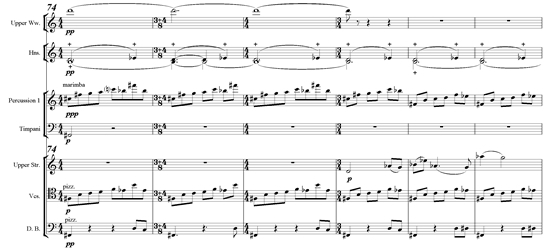
Symphony #6, 2nd mvt.: The marimba plays ppp, a twelfth higher than the cellos pizzicato, who are playing p. The marimba and cellos are heard as a unit, creating a novel and unusual timbre.
(repertoire example) Ravel, Bolero, 3 bars after rehearsal # 8: The horn, playing mf, has the main line here, doubled by higher octaves in the celesta, while two piccolos double respectively at a twelfth and two octaves plus a major third higher. This is very similar to a common organ combination (the “cornet”), which gives a rich, piercing sound.
- Heterophony: Rather than literal doubling, each doubled part can be an ornamental variation on the same basic contour. This keeps the overall design clear, but allows for individuality.
(repertoire example) Mozart, The Marriage of Figaro, Overture, m. 150 ff: Although upper winds and strings follow the same outline here, the differences of detail between them keep the orchestration light and transparent, even in a tutti.
- Doubling which becomes counterpoint and vice versa: Doubling need not stay consistent through a phrase or section. In particular, an instrument can begin a phrase as a doubling, and at some musically meaningful point – a change of motive, a climax, a cadence – become more contrapuntal, or vice versa.
(repertoire example) Mendelssohn, 4th Symphony, 1st movement, m. 140-145: Oboe 1 goes from simply doubling the main line in the strings (together with other woodwind) to supplying a subtle background counterpoint.
- Piece-meal doubling of several other lines: Doubling may move between various lines, thus creating new lines, which do not, however, add significant polyphony to the texture.
(repertoire example) Mahler, 9th symphony, 1st movement, m. 365 ff: The first horn starts as an inner counterpoint, then doubles the cello (m. 368), and then moves on to double the 1st trombone (m. 369).
- Partial doubling: Doubling may be partial, i.e. only of a few main motives in the phrase, just the beginning, or just the end of the phrase. In other words, one doubles only highlights. The doubling can then drop out, or become background resonance, settling down on a held note. The opposite (a held note becomes a doubling) is also possible.
(repertoire example) Mahler, 4th Symphony, 1st movement, m. 318: Here flutes 3 and 4 abruptly stop doubling the first violins – reinforcing the sudden dynamic change – crescendo into a “p” – in the latter.By individualizing doublings in these ways – creating a sort of pseudo-counterpoint rather than simply duplicating lines mechanically – the overall effect gains in subtlety and nuance. The players’ parts are also more individual and interesting to play.
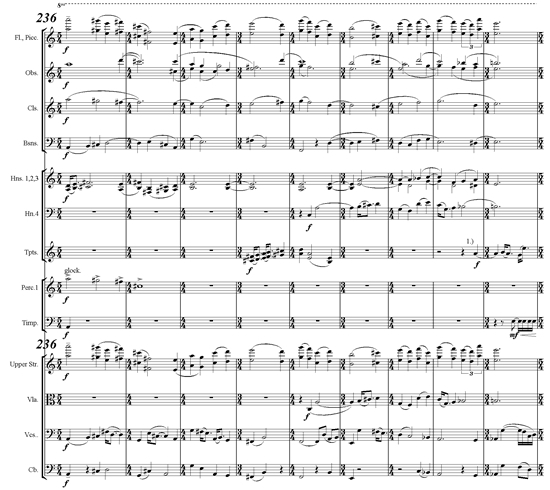
Symphonic Movement #1: This example illustrates several of the above techniques. The double basses have a simplified version of the main bass line (heterophony), and they drop out momentarily in m. 241-2; the glockenspiel doubles only the beginning of the main melody line, which is played by violins and flute/piccolo; oboes 1 and 2 alternate between heterophonically doubling the melody and real counterpoint; the clarinets have a simplified version of the melody. The overall result is a texture which is rich, but not heavy.
PLANES OF TONE
By “plane of tone” (D. F. Tovey’s term) we refer to one instrument, or a blended group of instruments, not necessarily from the same family, sharing one rhythmic outline. A plane may consist of one line or a textural mass. Simultaneous planes of tone are differentiated by perceptual prominence: Planes can be more or less equal, as in vigorous counterpoint, or they can fall into foreground (main lines) and various levels of background: secondary contrapuntal lines; figurations to add animation; harmonic masses; resonance.
As we have already mentioned, the listener cannot pay equal attention to several musical strands for any length of time. Even in contrapuntal music, the ear jumps from one part to another rather than following all the parts continuously. Therefore, the composer must have a clear idea of the role of each plane of tone in the texture; otherwise, confusion will result.
By definition, a plane of tone is a blended mass. Within a plane of tone, blend is achieved by similarity of timbre and rhythm, close spacing (no large gaps), and balance (all elements fairly equal in force). If there are disparate timbres, as in the woodwind, special strategies, such as close overlapping, are required to trick the ear into accepting the result as a unified whole.(repertoire example) Tchaikovsky 5th Symphony, 1st movement., m. 411 ff: Here clarinets and oboes are interlocked for better blend, in a standard classical technique.Between planes of tone, clear differentiation is essential. This is achieved by contrast of register, timbre, and/or rhythm.(repertoire example) Beethoven 6th Symphony, 1st movement, m. 97 ff: Here the theme stands out in the upper winds, while the strings accompany below.Planes of tone may be organized as equals (usually successively, as in a dialogue), or hierarchically.
In the case of a dialogue between equals, the planes must be similar both in loudness and in volume (“thickness”). Contrast comes from color, register, and rhythm.(repertoire example) Brahms 4thSymphony, Finale, m. 81 ff: Quiet chords in the strings alternate with chords in six woodwinds. Had the strings been louder, the woodwinds would have benefited from the addition of horns, for adequate volume.In the case of hierarchical planes, each plane will have its own distinct characteristics, according to its perceptual prominence. Although multiple foreground planes are not possible, multiples background planes can coexist.FOREGROUND
The foreground must stand out from the other elements. Therefore it is usually louder, in a timbre with a strongly characteristic color, and prominently placed (e.g. on top). Examples of this common situation abound.
BACKGROUND
Background: Background planes can be divided into two basic types: movement and resonance.
Movement
Movement in sound is the essence of music. In counterpoint, in harmony, and indeed, in all music, control of movement is critical. Orchestration brings another dimension to the issue of movement: As the number of instruments increases, if all the instruments are moving on the same rhythmic plane, the effect becomes more and more ponderous. Thus the need, even in a homophonic tutti of any length, for at least mild rhythmic differentiation between parts and families.
A more interesting situation, and one which uses the orchestra’s masses as an advantage rather than a weakness, is to supply background figuration, in a secondary plane of tone. Such movement animates the texture, lightens it, and provides shading, making the overall design more subtle. Many of the greatest feats of orchestration can be found in such situations, creating powerfully evocative atmospheres: Think of the start of Ravel’s Daphnis and Chloé, Wagner’s Ride of the Valkyrie, and so forth.
There are four basic types of orchestral movement, which can be applied simply or enhanced with contrapuntal touches – neighbor and passing notes, suspensions, etc.
- Trills/tremolos:(repertoire example) Wagner, Die Walkure, 3rd act, beginning: The “riding” theme is accompanied by trills in the winds, which add energy and momentum.
- Repeated Notes:(repertoire example) Beethoven 5th Symphony, 2nd movement., m. 205 (coda): The theme in the bassoon is accompanied by repeated chords (alternating with rests, which reinforce the tentative character) in the strings.
- Scales:(repertoire example) Wagner, Die Meistersinger, Overture, m. 42, ff: The scales in the strings (note the simplified bass part) add vitality to the majestic, chordal theme in the winds.
- Arpeggiation:(repertoire example) Brahms 3rd Symphony, 3rd movement, beginning: A beautiful string accompaniment emerges from the combination of rocking arpeggio figures in the strings.
To be successful, these kinds of movement (as opposed to full-fledged, foreground counterpoint), must not attract too much attention on their own. They must be clearly set off in a weaker plane of tone. They are usually limited to one or two mildly varied motives, with a high degree of consistency, and do not involve too many varied timbres. Often the accompaniment is lightened with rests.
Quick orchestral movement can also be used to reinforce musical direction: Rising and falling passages can be greatly enhanced by fast runs or scales, in winds or strings, harp glissandi, etc., in the basic direction of the passage, Such movement often takes slightly different forms in different instruments, so as to create general momentum rather than one thickly doubled line.(repertoire example) Strauss, Die Frau Ohne Schatten; 1st act, rehearsal #6: A wispy image of a rising shadow is created by using several different rising figures simultaneously (combined with held notes for resonance).These various types of movement can also be combined:
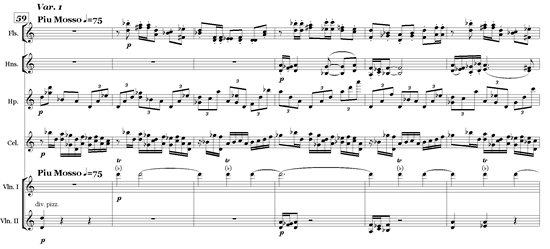
Variations for Orchestra: Harp and celesta play arpeggiated filigree work, with occasional non-harmonic tones, while the flutes cover the same harmony with repeated chords. The 1st violins add yet more animation with regular trills. All this serves as a rich background to the main line, in the horns.
Resonance
Resonance, the quietest of all planes, should not be noticed on its own. Therefore it is characterized by the softest timbres, the dullest registers, and the least activity. Also, resonance is usually in the same register as the foreground, so as not to draw attention to itself as something apart.
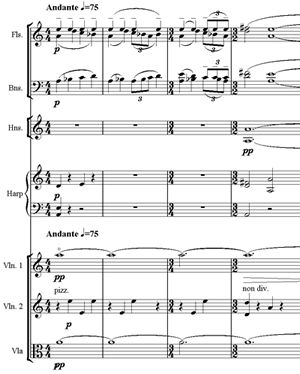
Symphony #8 (beginning): Delicate held notes in violins (harmonics) and violas provide mysterious background resonance for the main idea, which is presented in the flutes and bassoons.
(repertoire example) Mozart Symphony #41, 1st movement, m. 103 ff: The quiet held note in the oboe provides a subtle but poignant background resonance for the string theme.
Often, for richness, background planes are composed of multiple elements. Indeed, one sign of a master orchestrator is the refinement and depth of his orchestral backgrounds. Of course the various elements must compliment each other, and not confuse the listener: Rests and intermittent motives help to space out details, while maintaining clarity.
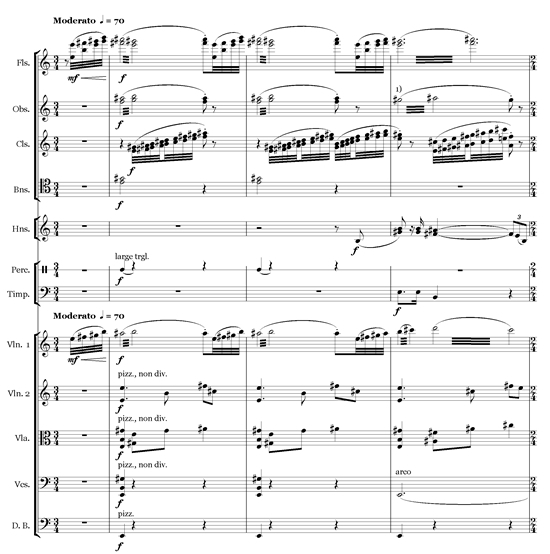
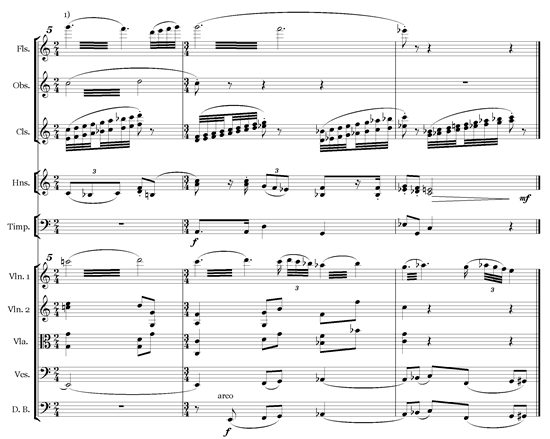
Night Passages: Energy and lightness result from high trills in woodwind and violins, combined with rising scales in the clarinets, which contribute momentum. Bassoons supply intermittent, gentle resonance in the middle register. The first two bars are each set off by a pizzicato chord and a triangle stroke. The pizzicato violas and 2nd violins are arranged as a dialogue. The arrival of the main line in the horns is marked by timpani, doubling the horns’ initial rhythm. These many details are arranged in repeating patterns, separated in register, and spaced out by rests, to keep them clear.
CONTRAPUNTAL ORCHESTRATION
The main difficulties in orchestrating counterpoint are:
- Achieving balance between the lines. Assuming all the lines are of equal importance, the simplest strategy is to give all the lines to the same family, or, if a thicker sound is appropriate, families: Each line is doubled by a similar combination of instruments. Assigning the various contrapuntal lines to different colors (pure or doubled) requires that the colors chosen be equal in loudness and in volume. This latter method can be tiring to the ear and is best used for short passages. It is more appropriate for stratified counterpoint (see our book on counterpoint) than for consistent imitative counterpoint.(repertoire example) Beethoven 7th Symphony, 2nd movement, m. 185 ff: All the counterpoint is in the strings.(repertoire example) Mahler, 5th Symphony, Finale, rehearsal #3: The contrasting themes are assigned to massed strings and massed upper woodwind. Note the violin trill, which adds extra animation.
- Marking entries. In counterpoint with frequent imitative entries, it is sometimes effective to treat the beginning of an important entry as an accent, orchestrally enhancing the first few notes in some way.
(repertoire example) Mahler, 5th Symphony, Finale, m. 136: Doubling the first few notes of the strings with the horn (in a luminous register) helps mark the beginning of a new section.
- Integrating the overall result into a coherent whole, and avoiding dryness. The Baroque basso continuo is (in part) a response to the need to bring contrapuntal textures into coherent wholes. While short contrapuntal passages in closely related timbres may occasionally be presented “as is”, it is usually a good idea either to add a complete harmonic plane of tone in the background, covering the middle register in particular, or to leave sustained “trailers” (held notes at the end of a phrase) behind the main lines from time to time. This helps avoid overly dry textures, and also mitigates aural fatigue.
(repertoire example) Mahler, 5th Symphony, 3rd movement, m. 799: The vigorous, tutti counterpoint is drawn into a rich whole by the sustained trombone chords.
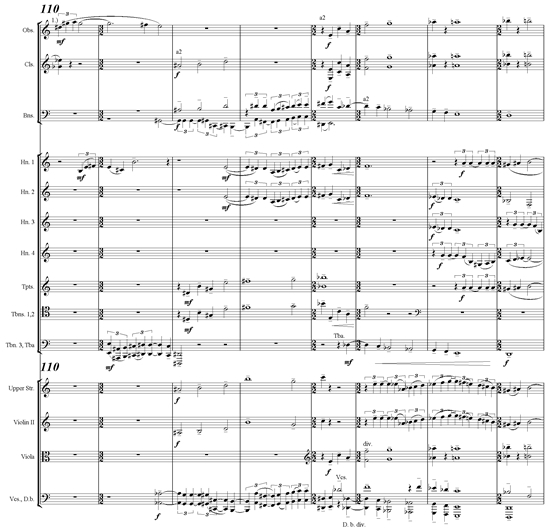
Symphony #6, 1st movement: Almost all of the lines are doubled by rich, mixed timbres. Most of the doubling instruments change roles at key points in their phrases, either to double a different line (e.g. Bn. 1, m. 112-113), or to stop, having emphasized an entry (e.g. Tbns. m. 114-115). Sometimes they leave behind a sustained note (e.g. Hns. m. 115), thereby avoiding dryness.
THE TUTTIOne can speak of a tutti when at least three of the four orchestral families are present. Since the number of instruments in such a grouping will inevitably exceed the number of audibly distinguishable real parts, the challenge of writing a tutti is to create a coherent, rich whole, where all the elements contribute something meaningful.
The acoustical realities of orchestral balance limit the number of ways a tutti can be organized. Brass and percussion are by nature the loudest sounds, and certain combinations (e.g. putting the woodwind in the middle register when the full brass is playing loudly) simply cannot work. Thus we reach the paradoxical conclusion that the more instruments are playing, the less ways there are to combine them. Many contemporary composers are led by this fact to write for the orchestra as a collection of chamber groups; at times this approach is enhanced by unusual spatial setups, which can create interesting stereo effects. However, it seems to me that if one writes for orchestra, all the instruments should play together at least some of the time.
Usually tutti passages are loud, but the occasional soft tutti (for example in the first movement of Beethoven’s 9th Symphony, m. 469 ff) can be very effective; the sound has something menacing about it, like a great power restrained.
The main ways of organizing a tutti are:
- Each family is complete in itself, but the details and part-writing are independent. This is the most common method; it gives a rich sound, without grayness. (Sometimes winds and, more rarely, strings, are left empty in the middle register when a large brass section is very fully scored; they would not in any case be audible in this register over the brass.) The overall harmonic unity guarantees coherence, and the differences between the families create richness of color.
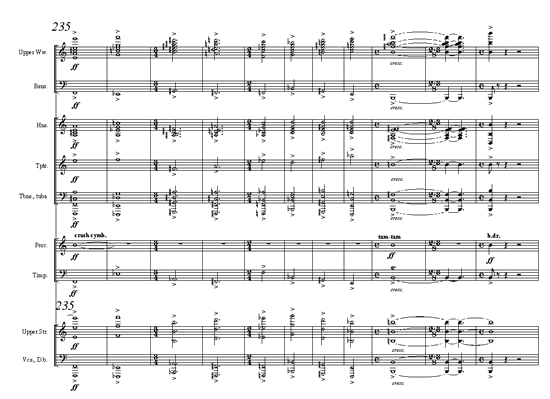
Symphony #5, finale: Strings play the outer parts in octaves. The bass is doubled in the bassoons, and also in the timpani (with a few octave displacements), while the upper woodwinds fill out the harmony above the horns. Note that the trumpets and the highest woodwind have lines which are not the same as the string melody: This arrangement gives a richer result than literal doubling. Trombones and horns have full harmony, in the middle/low register. Cymbals, tam-tam, and bass drum mark important accents.
(repertoire example) Wagner, Die Meistersinger, Prelude, beginning: Each family has independent partwriting. Although the winds start off doubling the main melody in the violins, by m. 7 they are already adding details of their own.
- Each musical element is given to a distinct family, or combination of families. This method has the advantage of bringing out each musical element clearly, differentiating it from the others through timbre.

Symphony #6, finale: While the brass play an important harmonic motive, along with its diminution, strings and winds move more quickly and nervously in eighth notes. This doubling is necessary to ensure that this idea will penetrate the brass chords. Note how the piccolo in particuliar clarifies the quick line.
(repertoire example) Tchaikovsky, 5th Symphony, Finale, m.474 ff: While strings play the main melody in octaves, horns and winds provide two important contrapuntal accompaniments. The repeated note accompaniment is in lower brass plus double basses.
- The third method is simply to literally double all the parts in each family. While occasionally suitable for short, vigorous passages, this method usually sounds heavy and gray.
